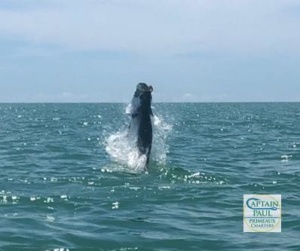Sanibel Tarpon Fishing in Florida

This fish was landed as the hook broke. pushing 200 lbs estimated.
Welcome! You found this page because are on two types of people. Those who are addicted to Tarpon fishing and those that will be addicted to Tarpon fishing.
I started Tarpon Fishing around Sanibel Florida in 1987 and quickly began fishing tournaments numerous top 10 finishes and just one-afternoon bite away from winning. That didn’t deter me and 33 years later still at it. Trying to write about this is a little mind-boggling so I will try to keep it simple.
There a number of tried and true methods of fishing for tarpon.
Breaking it down, knowing someone with experience and joining a local fishing club and
even better a Tarpon Hunters Club is the way to dramatically shorten your learning curve.
In our area, the Fort Myers Beach Tarpon Hunters Club is the oldest club established solely
for Tarpon Fishing. They hold an annual Spring Clinic in early March. Simply attending
this meeting alone, learning from the combination of untold years of experience willing to be shared.
If there is a clinic or a club, seek it out if you’re just starting, even experienced Tarpon fishermen can pick up a new tip or two.
- Seasons — When to catch As with any fish, there tends to be a peak season and the Silver Kings are in the highest numbers from Spring through mid-summer. Naturally its all dependent on your location.
Spring and Summer for Southwest Florida. If you want to get an early jump on the season, head on down
to the Florida Keys or Marco Island or Chokoloskee and the 10,000 islands.
Tarpon Fishing can range from you cant keep bait away from them to “Lock Jaw” despite
being surrounded by hundreds of fish rolling and seemingly thumbing their whip-like Dorsal
fins in your face. This snubbing, they are famous for.
There are 3 primary methods of fishing for Tarpon. Live Bait, Dead Bait, and Fly Fishing or Artificials.
I started out dead baiting as it was the way to catch multiple hookups and win tournaments.
Over time, that method is still popular but probably not the most anymore.
We used 125lb leaders and would wear through some times. 40 lb test on bait caster reels were standard.
The old Penn 113H reel was probably the defacto standard. the drags would heat up and be real
grabby and lead to jerky runs. This did not help with already difficult hooksets. The Shimano
TLD’s were a miracle with silky smooth lever Drags vs the Penns. 6500 sized Spinfisher Reels have pretty much taken over with great engineering improvements.
- Dead Bait– Here is how it would go, we would load up on dead mullet and preferably “Shad” or Bunker. Atlantic
Menhaden is what they really are. The tarpon would eat them like candy, but so would the catfish sharks and crabs so you had better bring a lot. We would try to get 3-4 Doz but 100-200 was better and the fresher the better. Any red around the gills or eyes not clear were “chummers” That allowed for “chunkers” and time-honored practice of Chunking or small pieces cut up and doled out steadily. This was often the job reserved for the least senior crew member. This works great for a variety of fish here, especially Sharks.
Then it was a waiting game. Sometimes the hit would come before it hit the bottom and sometimes a 3-4 hour wait.
Often you would be rewarded with spectacular show and if you were lucky a double or triple hook-up.
While Dead baiting with up 2-4 lines in the water with a rubber core up to 3/4 oz sinker to keep it on the bottom if necessary, you should also freeline or cork float a live pinfish and or a thread-fin herring or a silver dollar size blue crab, the top live baits, to find out what the fish preferred that day. I always keep some jumbo shrimp too just in case. Often if they won’t hit anything else often that will do the trick.
- Live Bait–
Mostly done with Heavy Spinning tackle with 5500 to 8500 sized reels spooled with 50 lb braid and 50-60 lb line often on floats makes it easier to make long casts to rolling or traveling fish. - Artificial Baits–
Plastic swimbaits on lead head jigs are extremely effective. Yozuri Plugs, Mirro-lures,
are the favorites. DOA Bait busters in Silver or Green/Silver Known as “reaction” baits they can trigger a strike often times when nothing else will. - Tarpon Flies–
I have great luck on several flies over the year but the first one I ever got hit on was an old standard
the venerable Cockroach, Tarpon Toads, Black Death, and Puglisi Black and Purple.
As I realized when I started, it is very difficult to cover the variables in a short article.
So get on out there and get yourself a tarpon. It never gets old. Fortunately, there are by-catch of grouper
and or cobia from time to time. And the wandering triple tail that will take up residence under your boat.
If you prefer to book an experienced guide give me a call. 239-292-9890
Capt Paul Primeaux
Sanibel & Captiva, FL